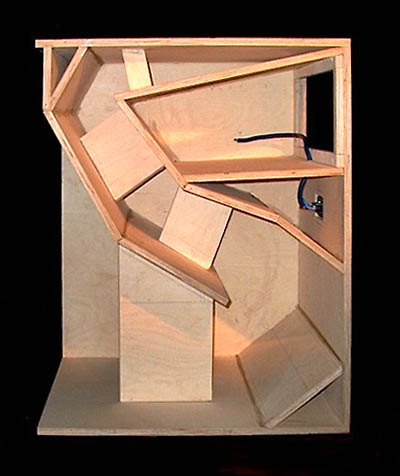|









|
Another great job on some 1850 horns. Julz said "Last weekend we used
the PD1850 Horns, The Seleniumís and my OHM TRS 218/212 rig with some
Vitavox compression horn tops outdoors and it sounded wonderful...sweet,
loud with loads of kick". He also has a few comments and tips to share
with us. I have also added a few words about his comments.
We had the sheets cut to 600mm wide (for all the interior and back
panels) at the timber yard, and 750mm wide for the tops and bottoms.
That left us just cutting the lengths and the mitres. There are a couple
of cuts that caused a headache, the principle one being the panel at the
base of the speaker compartment as the join where it meets the rear
panel is at a very small angle and we ended up just using a plane to
shave a millimetre or two of the angle rather than saw it. Butting up
the access panel holding strips and sealing cured any imperfections!
Rog : What you need to make mitres over 45 degrees is a table saw with a
vertical work clamp, also known as a tenanting jig. If you don't have
one of these you could make a jig to hold the panel you are cutting up
higher at the fence end of the saw. If your saw blade is at 45 degrees
and you hold the panel to be cut at 5 degrees to the table, them you
will get a 50 degree mitre.
The access panel is only just large enough for the driver to fit through.
Let's hope it never needs replacing as the access to the front two bolts
is going to be *very* tight!
Rog : It is a tight fit with this driver but I normally design cabinets
with small access panels. The 1850 horn should give you at least 20 mm
clearance for the driver, this is double the 10 mm clearance I normally
allow for access panels. You have to be accurate with your measurements
and cutting as accumulated errors can mean that things can get a bit
tight around the access panel. You should be able to work to at least a
1 mm tolerance when building cabinets, I always cut and build to a 10th
of a mm accuracy.
We decided to not measure and cut the braces from the plan, but to cut
them once the panels are in place to ensure an exact fit.
The holes were cut with a router and jig as you suggested...a very good
tip indeed...
I concur with your other builder who cautioned about not being able to
easily screw and locate things if done in the wrong order, but it is
possible...The particular area of concern were the large braces at the
bottom of the throat, where they meet the inside panel.
Rog : I'm a bit confused with the last line, I take it you mean the two
braces that sit in the mouth and brace the bottom of the cabinet to the
last two flare sections.
Everything fitted together well, but we found the use of sash clamps
were beneficial in holding the panels in place whilst the glue set. This
made assembly slower than we would have liked, but the result was worth
it.
Rog : I've never had to use any clamps to hold panels together whilst
they dry. I can't see the benefit of using clamps, if you didn't use any
screws then clamps would be necessary, but if you use screws I don't see
what the clamps would be doing apart form getting in the way.
The joins of the interior panels were sealed with a Evo Stick filler/glue,
sanded and will be painted over to ensure a smooth, gap free surface.
Rog : If the join is made correctly in the first place and you used glue
to assemble the cabinet why are you gluing the joins again. If it is to
fill gaps then 1. there should be no gaps. Use of the correct tools and
taking enough time to do a good assembly should result in the cabinet
needing no further filling or gluing and 2. if you do need to fill use a
good wood filler or better still a 2 pack resin filler. If I had to seal
joins later it would mean that I had failed to construct the cabinet
well enough for proper use. If I felt the build was going that bad I
would start again and take more time to get it right. If you have glued
the panel on correctly then the join should be stronger that the wood
it's self. Any attempt to break the join should result in the wood
around the join snapping before the join breaks, if this does not happen
something is wrong.
Julz powers the 1850 horns with a Crown MA 5000 VX and is going to make
some MT 122's to go with the bass horns soon. His system should sound
really good.
|
|



 Home
Home
 Plans
Plans
 Readers Projects
Readers Projects
 System Photos
System Photos
 Guide
Guide
 Links
Links
 FAQ
FAQ
 Forum
Forum


 Home
Home
 Plans
Plans
 Readers Projects
Readers Projects
 System Photos
System Photos
 Guide
Guide
 Links
Links
 FAQ
FAQ
 Forum
Forum